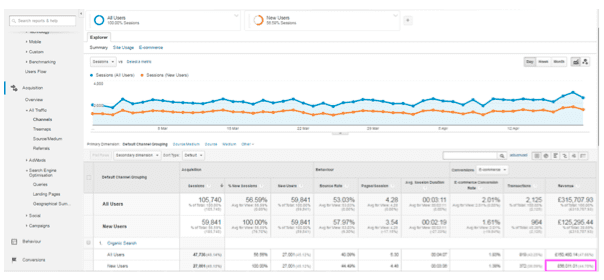Knowing if you’ve got a successful retail SEO campaign all starts with picking the right metrics
With a wealth of information at your fingertips in Google Analytics, how do you determine what the key performance indicators (KPIs) are for your website? Everyone wants to demonstrate the value of organic campaigns but since the cruel and unusual punishment of the removal of the organic keyword conversion report in Google Analytics to be replaced by the opaque 'not-provided', it can seem difficult to measure the impact of all the hard work although the improved Search Console-Google Analytics integration does help. Before we dive into the KPIs, it’s important to remember a few things when you’re pulling data out of Google Analytics and drawing conclusions from this…
What is data without human interpretation?
As with any quantitative data you get the what but not the why. Human interpretation of this data is where the value is added. And for us as marketers to assess the success of SEO metrics like revenue over a particular period like a month, we must compare it against previous data (should we be lucky enough to have this).
Download Expert Member resource – On-page SEO guide
This resource is a practical template aimed at helping content editors to improve how they create and update copy for web pages to improve their ranking in the organic search results of Google and other search engines.
Access the On-page SEO and copywriting template
Choosing the right data to compare against
- For almost all businesses seasonality plays a crucial role in the sales cycle so comparing month-on-month will often not indicate incremental growth.
- Year on year comparisons are what you want to be looking at in most instances, whether you’re taking a month’s worth of data, a quarter or a year, the best way to judge improved performance is by looking at that same period of time from a year previous.
One thing to consider during this analysis is the changing retail and industry calendars, as well as seasonal changes like where bank holidays fall. For example, before a couple of years ago, Black Friday was just something we heard crazy Americans partaking in during a post-turkey frenzy and definitely not the central event in the UK retail calendar that it has become over the past couple of years. That may result in November robbing some of your traffic that typically falls in December explaining the year on year increase in November traffic and decrease in December traffic.

1. Ecommerce Revenue From SEO
The number one KPI to measure the success of your SEO campaign for ecommerce websites has to be revenue. Sure, traffic is nice but ultimately you’re sending the traffic there to buy. I’m sure this is no revelation to most marketers to measure revenue by channel but sometimes in organic search, people can get carried away with “vanity metrics”.
Getting number 1 keyword rankings for very generic terms, or sending a high volume of traffic to a website might look impressive but is it ultimately helping your business achieve its goals? Particularly for ecommerce websites, the value of sending a high volume of traffic with little intent to purchase is hard to measure and fully understand. Conversely, sending highly relevant traffic comprised of your target audience makes great business sense and that’s why measuring the ecommerce revenue driven through SEO is usually the top metric to indicate success.

You're particularly interested in new visitors from SEO who don't already know the brand, so with Search Console you can get an indication of non-brand keyword visitors who Google is introducing to you for the first time. However, the search console doesn't cover all keywords, so you have to turn to other alternatives like attribution of our next technique.
2. Ecommerce SEO revenue from new visitors
We all know that SEO is great for introducing your brand to new customers that are interested in your product. Attracting new consumers and growing your customer base doesn’t come easy and looking at the revenue driven by new visitors is a nice metric to give value to this work. If you have year on year data to compare against, this data will create the most accurate representation of business growth.
Of course for most retail brands customer lifetime value should be taken into consideration, particularly when you’re thinking about the value of attracting new customers. Put simply, you may spend £50 attracting a customer that purchases a product for £90, which doesn’t seem very exciting unless you consider this customer could be coming back every month and spending £100 for the next 5 years or so…

3. Number of SEO Transactions
Looking at ecommerce SEO transactions will give you a good indication of the success of organic campaigns without having to account for average order value. It’s not that revenue or average order value isn’t important, but SEO is largely bringing new customers to your site and new customers will typically spend less on their first purchase.

Mixing in new visitors with your loyal customers may show the average order value and conversion rate go down, this is because you’re persuading a new customer to give your brand a try! So when you might see these metrics go down a little, comparing transactions against previous data will hopefully show that your customers are still buying! Besides, new customers might spend less with their first transaction but as we’ve already mentioned there’s an entire customer lifetime value to consider!

Olivia Collins is Digital Marketing Executive at Digital Marketing Agency
ThoughtShift, an award-winning agency specialising in increasing eCommerce SEO and PPC sales. Olivia writes regularly on the latest trends in digital marketing and consumer behaviour online. Follow ThoughtShift on
Twitter for
LinkedIn for bite-sized digital marketing tips.








 Olivia Collins is Digital Marketing Executive at Digital Marketing Agency
Olivia Collins is Digital Marketing Executive at Digital Marketing Agency 


